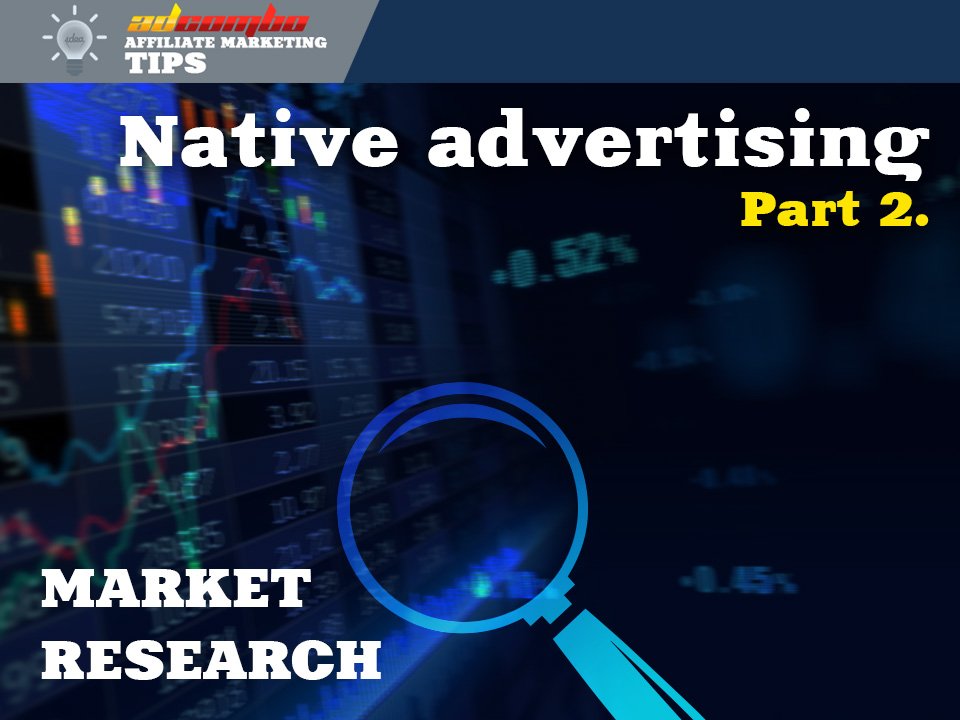-
 Native advertising. Part 2. Market research.07.3.2017Reading Time: 6 minutes
Native advertising. Part 2. Market research.07.3.2017Reading Time: 6 minutesIn 2016 native advertising was arguably the biggest buzzword in digital advertising. Coinciding with questions surrounding the future of display, the looming threat posed by ad blockers and a need among publishers to get creative when monetising their content, its upward trajectory and ability to carry the display baton could not have arrived at a better time.
Regardless of what we’ve seen so far, its rapid rise to prominence last year is only the start. Native placements – effectively ads that form part of the environment on which they sit – are expected to represent even bigger business as advertisers and publishers look to capitalize on formats that resonate with today’s audiences.
In the US, for example, the Interactive Advertising Bureau tips native to represent 74% of all spend on display by 2021, up from a mere 56% in 2016, equating to a total of $36 billion.
Similar studies show Europe following the same trend. Enders Analysis has the continent’s native spend at €13.2 billion ($13.9 billion) by 2020, representing 52% of all display ad spend, rising from €5.2 billion ($5.5 billion) in 2015.
Yet, despite native shaking up the display ad economy as we know it, a familiar process dictates how this inventory is acquired and sold. Networks provide the easiest way for publishers and advertisers to connect with each other, and now the market is crammed with platforms dedicated to the trading of native ad space.
Here are some of the key considerations for linking up with a native ad network from both an advertiser and publisher standpoint.
Selecting ‘the one’
Recent growth in native means there is no shortage of platforms ready to take on new users. The first obstacle is the sign-up process, which can be stringent on networks which pride themselves on being able to offer a premium service to advertisers.
Some platforms will broadcast their relationships with big-name publishers like CNN and New York Post, require good levels of traffic from the sites they use (sometimes over tens of thousands of impressions per week), and that’s before their own checks on the suitability of each site and advertiser.
With networks like AdNow, publishers managing even a modicum of traffic can get started within five minutes courtesy of a short form and a selection of ready-made widgets. The network still offers a safe environment for advertisers and publishers to connect, but with a much easier point of entry than some of its competitors.
Advertisers are often required to fill in basic details about their company before uploading creative, again, with background checks taking place on certain networks to ensure quality on their platforms.
For publishers, the first steps are to list their domain, location, language, and traffic, with some networks requiring more of a deeper dig into things like audience demographics, content types and their subjects of interest.
Choosing the ‘right’ network rests on the specific criteria demanded by advertisers and publishers alike. If you’re an advertiser with a premium offering, less emphasis will be placed on a network’s figures for impressions and users as well as the length of the sign-up process, with much more of a focus on the quality and profile of publishers at their disposal.
Being able to target specific geos and link up with publishers based on their audience demographic is useful, but things like local language support should not be underestimated by advertisers who are targeting foreign markets.
As for publishers, strong CTRs (anything around 1% is a good barometer), the option of connecting with well-known or specific types of brands, a guarantee on safe ads as well as the frequency of payment and support of popular terminals like PayPal are key things to bear in mind.
Otherwise, it pays to look into online reviews from both sides of the trading process, which can unearth useful verdicts on things like customer service: an asset of great significance for someone trying native for the very first time.
Campaign types
Although most people associate native advertising with content discovery – occasionally guessing as the ‘related articles’ you sometimes find at the end of a piece of editorial – there are plenty of other formats to choose from.
In Europe, for example, Enders Analysis has witnessed growth in native being driven partly by videos placed within streams of content. This is part of the same ‘in-feed’ family as social native: the format adopted by social networks like Facebook and Twitter, who use sponsored posts to monetize a largely free-to-use offering.
Each native ad network has its own list of supported formats, but while it’s fair to say that content discovery is the dominant option, many platforms do offer the sort of in-feed inventory that allows publishers and advertisers to showcase their content on a large scale.
Far more cut and dry are the rules and regulations for any advertiser or publisher wanting to use native for their own benefit.
Networks conduct routine inspections on publishers to ensure they are not posting content considered ‘spammy’, with the worst offenders banished. Sites also need to keep an eye on how they are positioning their content, as failing to highlight the presence of an ad or sponsored editorial can result in an even greater penalty via groups like the FTC in the US and the UK’s Advertising Standards Authority.
Citation is also triggered by advertisers and publishers found to be promoting adult or inappropriate content, as the network will always aim to avoid bad PR and customer complaints where possible.
Each network will have its own criteria on what is and isn’t acceptable, with this often outlined either during the sign-up process or within their on-site FAQs.
Getting started
Once you’re signed up, the next step is to get native working for you as well as it does for your competitors.
For publishers, it all starts with content. Whether they’re gunning for social shares or using SEO for maximum benefit, catering for an audience with a catchy headline and topical subject matter is where the conversation starts.
In the case of content discovery, the baton is then passed to the advertiser, who will often use another article on their site to continue the conversation before directing the user to a product or service. Publishers on native advertising networks will often get paid on a cost per click, so their job is done once an impression or engagement is completed.
Then, akin to the workings of other performance-based channels like pay per click and display, it’s up to the advertiser to convert the users they pay for.
Of course, the process doesn’t always follow the aforementioned route. It could be that publishers charge their advertisers on a cost per mille; cost per action (CPA) is an option on some networks, much like in affiliate marketing, along with cost per install (CPI) for the benefit of app developers.
Generally speaking, native is a highly effective way of directing a user from one site to another, which is why paying for clicks is so popular when venturing down the network route.
The cost of a click on a network can range from around $0.05 up to $5 and beyond according to competition, the amount of content you submit, as well as the perceived quality of the publisher and their inventory; running in line with the rule that some sites will re-direct a higher quality of user.
The trial phase should see bids floating around the $0.25 mark; enough to highlight the correct strategy going forward.
Bidding best practice can vary according to each platform, but experts have been known to suggest a high budget against a low bid when starting out. This allows advertisers to capitalise on a drop in demand towards the end of a day, thus getting them seen at less of an expense. If targeting on a CPA, this may even be seen as a coup due to typical conversion times on certain products or services.
Targeting specific users is another action that can bring the bidding rate up. It’s easy to see how zoning in on an iOS-using millennial in Germany with a propensity to spend with a specific type of advertiser can come at a cost. This is why it pays for advertisers to keep things broad at the start of using native before they know that targeting certain profile results in a good outcome.
For monitoring and optimising a campaign, setting a minimum of what to expect in terms of a click-through is one of many ways to weed out ads that are are not performing. The same approach of setting a minimum goal on different metrics also makes sense when attempting to drive for a specific objective, like awareness, traffic or engagement.
To recap, here are the five golden rules for working with native ad networks, applicable to publishers and advertisers:
- Choose the network for you – Whether you’re a publisher only managing small amounts of traffic or an advertiser looking to build huge awareness in a short space of time, you should pick a network which answers your specific criteria. Native is a competitive arena and you should find a platform which offers your requirement as a USP.
- Be wary of safety – Publishers should watch out for referring to sites that might do their brand more harm than good. The same applies to advertisers, largely due to recent issues with click fraud.
- Be truthful – Networks expect the sites they use to be transparent about their audiences and how they’re using native. They have ways of finding out where users are being deceived, so it’s best to remain truthful.
- Respect the format – Advertisers paying for clicks towards a landing page ridden with pushy sales messages will only risk a bad performance. Native can allow a much easier, more seamless tie from content to sale, but only if care is taken in doing so.
- Bid smartly – Optimisation is the key word when starting with any network and the same applies to native. Advertisers should keep things broad at the start of their journey and build from there.





Leave your comment